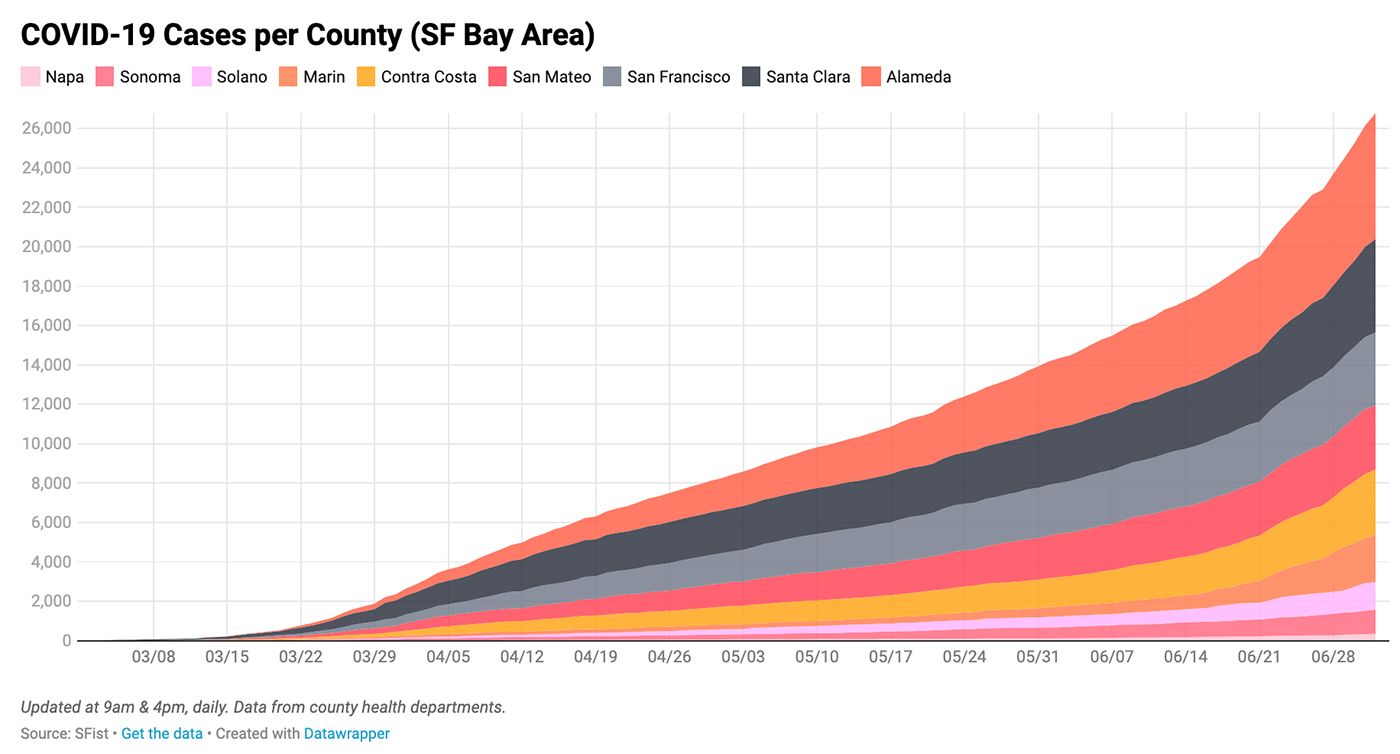As a metric of where a region is in this pandemic, rising rates of hospitalization for severe COVID-19 cases is not a good sign. Cumulative case counts may rise as testing becomes more widely available and more people decide they should seek a test — but upticks in hospitalizations mean that the virus may be spreading quickly and more severe cases are bubbling up as asymptomatic ones go unconfirmed, and an uptick in deaths could soon be on the way.
Using county data that's been published by the state since April 1, SFist found that the nine-county Bay Area has been seeing a rapid rise in hospitalizations in the last two weeks that is approaching a peak not seen since early April. Around April 6, the Bay Area had 467 confirmed COVID patients in hospitals, and as of Thursday that number has risen back to 745 — a 26-percent uptick since Sunday.

Significant upticks in hospitalizations have been seen in recent days in Alameda County, where the number of beds occupied by COVID patients has risen 55 percent since mid-June; in Contra Costa county where hospitalizations have doubled from 22 to 41 between June 12 and June 30; and Solano County where hospitalized cases have nearly tripled in that same period with a total of 48 patients now in hospitals.
The Chronicle has picked up this trend line as well, which coincides with upticks in overall cases. And they spoke to nurse Becky Cherry-May at Kaiser Permanente Vacaville Medical Center, where there are currently 10 COVID-positive patients.
"I’m very concerned. We’re going into a very bad place," she tells the paper. "We’re just starting our surge."
Since May 31, confirmed cases have more than doubled across the Bay Area, from 12,000 to just under 27,000 today.

So, in case you weren't aware of these trends, it may be clearer now why San Francisco and other Bay Area counties decided to pause their reopening plans this week in favor of more caution — and it looks like even without bars, sporting events, or indoor dining happening, cases are rising nonetheless.
Does this have something to do with a mutated strain of the coronavirus suddenly taking hold locally which is more adept at replicating? Possibly, some experts would say, though not all epidemiologists seem to agree on the idea that we have a more aggressive strain — Dr. Anthony Fauci has urged some caution about this, but says it is still cause for concern.
What seems clear is that the hospitalization rate won't trend downward without the kind of severe curtailing of people's lives, which is what brought it down in April. And that is a tough pill to swallow as the weather warms and everyone has already been emerging from their cocoons for weeks.
The Chronicle also points to capacity issues arising for hospitals around the Bay, including in San Francisco, where UCSF Parnassus reports that its ICU beds are currently 82-percent filled with mostly non-COVID patients. In Sonoma, where there are just 16 COVID patients in the ICU, ICU beds are now 84-percent full.
Another reason for concern is that San Francisco hospitals have been accepting patients from other counties in the state as those counties' hospitals reach capacity — which may further strain capacity in the city. The numbers of COVID patients from other jurisdictions now have to be separated from SF's daily hospitalization census.
Multiple stories came out of New York hospitals in March and April — and from elsewhere in the world, like in Italy — that suggested that more deaths occur when hospitals are overwhelmed and can not give adequate levels of care to each patient.
On Wednesday, Governor Gavin Newsom ordered indoor dining, bars, and movie theaters to cease operations in 19 counties currently on a state watch list — and three Bay Area counties, Solano, Contra Costa, and Santa Clara, were on that list.
Long story short, stay home more than you'd like to, and wear masks when you don't!

